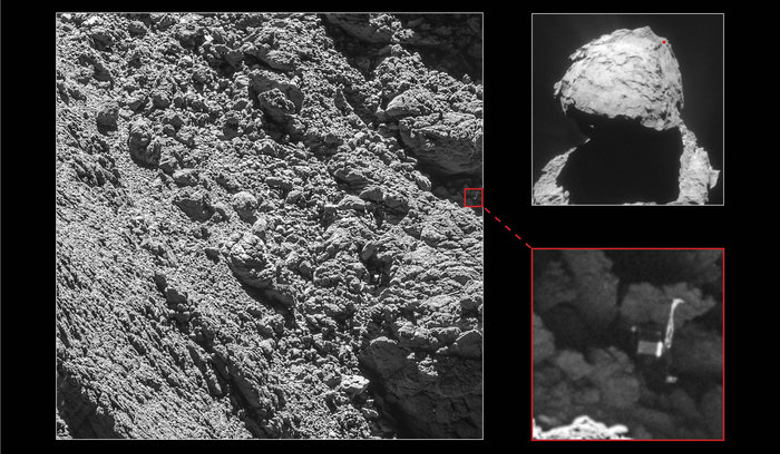With less than a month before the Rosetta mission comes to an end, the spacecraft’s high-resolution camera has finally spotted the Philae lander, whose precise location until yesterday was still not known.
Now wedged into a dark crack on comet 67P/Churyumov–Gerasimenko, the lander was last seen when it first touched down at Agilkia – Philae’s target landing site, named after a small island along the Nile River – and after an unanticipated bounce and a further two hour flight, the lander ended up on the comet’s smaller lobe at a location later named Abydos.
Images of the lander, taken on 2 September by the OSIRIS narrow-angle camera clearly show the main body of the lander, along with two of its three legs. As Philae’s orientation can also be distinguished it helps to explain why establishing communications with the probe was so difficult following its landing on 12 November 2014. “With only a month left of the Rosetta mission, we are so happy to have finally imaged Philae, and to see it in such amazing detail,” says Cecilia Tubiana of the OSIRIS camera team, the first person to see the images when they were downlinked from Rosetta yesterday. “This remarkable discovery comes at the end of a long, painstaking search,” says Patrick Martin, ESA’s Rosetta Mission Manager. “We were beginning to think that Philae would remain lost forever. It is incredible we have captured this at the final hour.”
Dropping a lander onto a comet hurtling around the Solar System was an extraordinary feat in its own right and Philae will go down in the history books as being part of a mission that (mostly) overcame the tremendously difficult technical challenges that was set before it. If the lander had stuck fast and not bounced, it is doubtless that scientists would still be wading through the data supplied by the lander. However, three days after Philae got lodged in the dark crack, its primary battery was exhausted and the lander went into hibernation. It did wake briefly as the comet came closer to the Sun and more power was available. Nonetheless, the last time Philae was heard from by Rosetta was in July 2015.
“This wonderful news means that we now have the missing ‘ground-truth’ information needed to put Philae’s three days of science into proper context, now that we know where that ground actually is!” says Matt Taylor, ESA’s Rosetta project scientist. "Now that the lander search is finished we feel ready for Rosetta's landing, and look forward to capturing even closer images of Rosetta's touchdown site,” adds Holger Sierks, principal investigator of the OSIRIS camera.
Unfortunately however, the end is nigh for Rosetta, as the spacecraft’s ever-increasing distance from the Sun and Earth means it will receive significantly reduced solar power in order to operate the craft and its instruments. As such the spacecraft is set to complete its mission in a controlled descent to the surface of comet 67P/C-G on 30 September 2016.











